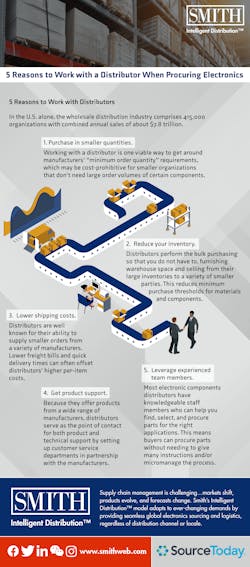5 Reasons to Work with a Distributor When Procuring Electronics
A crucial link in the electronics supply chain, distributors fulfill a dual role both by representing manufacturers and ensuring that customers get the parts and components they need to run their own operations. Much more than just “middlemen,” distributors also provide value-added services, technical expertise and customer support that manufacturers would otherwise have to orchestrate themselves (if at all, and particularly in the case of value-added services).
“In the world of the supply chain, an electronic components distributor plays a significant role in providing industrial and commercial businesses with the parts they need,” Pushkar Kathayat writes in “Benefits Of Using An Electronic Components Distributor When You Need Parts.” “The distributor, for instance, is responsible for the supply of the electronic components that manufacturing companies and other related industries require for their jobs.”
Because most component manufacturers lack the infrastructure needed to serve thousands of businesses worldwide, he continues, “distributors are there to provide a massive number of companies with different parts from various manufacturers.”
5 Reasons to Work with Distributors
In this U.S. alone, the wholesale distribution industry comprises 415,000 organizations with combined annual sales of about $7.8 trillion. A complicated process that’s best managed by a competent, experienced organization, electronics distribution involves stocking a wide variety of inventory, staying out in front of an ever-evolving industry, adding high levels of value for customers and keeping a finger on the pulse of the market. And while there are of course pros and cons to working with a distributor versus a manufacturer, the reasons for taking the distribution route include:
- Purchase in smaller quantities. Working with a distributor is one viable way to get around manufacturers’ “minimum order quantity” requirements, which may be cost-prohibitive for smaller organizations that don’t need large order volumes of certain components.
- Reduce your inventory. Unused inventory is a financial burden for any company, and distributors know this. “Purchasing from a distributor offers a clear advantage for manufacturers because distributors, as a go-between, perform the bulk purchasing so that you don’t have to,” Thomasnet points out. “They furnish the warehouse space and sell from their large inventories to a variety of smaller parties, including yours, thereby reducing your minimum purchase threshold for materials and components.”
- Lower shipping costs. Distributors buy in quantity from several manufacturers and warehouse the goods for sale to retailers. Although their product prices may be higher than what the manufacturer is offering, distributors are well known for their ability to supply smaller orders from a variety of manufacturers, Entrepreneur points out. “A lower freight bill and quick delivery time from a nearby distributor often compensates for the higher per-item cost,” it adds.
- Get product support. Because they offer products from a wide range of manufacturers, distributors serve as the point of contact for both product and technical support. “They do this by setting up customer service departments in partnership with the manufacturers to offer the kind of support their customers need,” Kathayat writes. “The customer support setup, for instance, is helpful when it comes to solving technical issues and making wise purchase decisions about the right electronic component.”
- Leverage experienced team members. Most electronic components distributors have knowledgeable staff members who can help you find, select, and procure parts for the right applications. This means buyers can procure parts without needing to give many instructions and/or micromanage the process. “Lastly, they also study the market trends,” Kathayat writes, “and pay personal attention to offering top-notch services to customers.”
About the Author

Bridget McCrea
Contributing Writer | Supply Chain Connect
Bridget McCrea is a freelance writer who covers business and technology for various publications.








